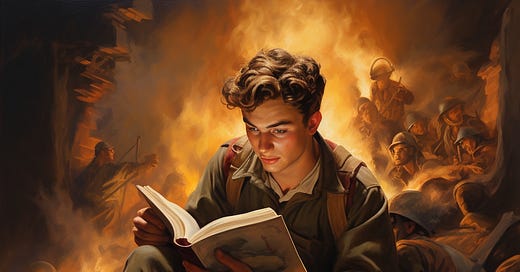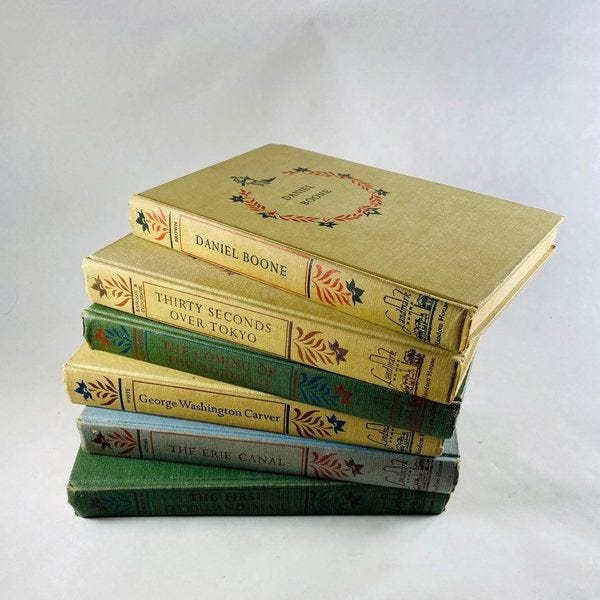Editor’s Note:
Zack is back! This week he continues his “Based Boys Books” essay series highlighting the timeless tales of young men's adventure fiction and offers his recommendations. This series is quickly becoming a personal favorite of mine in the P3 catalog.
Enjoy!
- Frank Theodat
As we continue to build the ideal library for the self-reliant and self-taught young man, we need to add some nonfiction to his collection. For a number of reasons, there might be no better place to start than the vintage treasures contained in the Landmark series. This monumental achievement in historiography expressly designed for adolescents is also an excellent example of the sort of market research we aspire to at this magazine. Supposedly, the head of Random House could not acquire a suitable book on the Pilgrims for his young son, and his frustration turned into a product line which ended up containing over two hundred titles running from 1950 to 1970. A case study in What to Do Right when publishing this sort of material, it’s time we revisit these classics for our own enjoyment and the instruction of our posterity.
First off, when creating material for boys you must to live and die by the exact inverse of the tired “Don’t Judge a Book by It’s Cover” saw. Being eminently reasonable creatures, boys know that a failure to appeal visually probably indicates other failures internally, and judge accordingly. So Random House designed a complimentary livery of single-colored cloth bindings that, to this day, feel important and inviting in the hand. This design also has the added benefit of immediately colonizing one of your bookshelves, each new Landmark that slides into place cumulatively contributing to a moreish collecting habit. I mean, just look at these:
Next they were clad in brightly illustrated jackets, depicting an exciting scene within enticingly. No coy disguised motives here or mind-numbing scholastic stuffiness; a Landmark on the bookstore shelf screamed “Hey, history rocks, dudes rock, and you’re cool just for considering this book. Want to read about the Exceptional Chadness of Geronimo? Yeah you do, king!” This is the exact opposite of the Eat Your Vegetables insistence of imaginatively impoverished so-called educators. A Landmark promised adventure, entertainment, and knowledge of the wider world. They appealed to boys’ desires to gather facts, their collector’s habit, and their fledgling need to grapple with serious Real Life events and characters, turning all these things into leverage to mold the scholars and statesmen of tomorrow.
And then, crucially, the books delivered. Random House wisely reached out to established authors who could write excellent prose instead of relying on academic historians, and so each of the books reads like a David McCullough epic shrunk to a manageable 250-ish pages. They snagged well-known names for a number of the works: WWII Pacific veteran and superb pensman Robert Leckie for several war stories, Horatio Hornblower creator C.S. Forester for a Barbary Pirates volume, William Shirer for an adaptation of his Rise and Fall of the Third Reich tome, fictioneer Shirley Jackson for a Salem Village Witch Hunt book, and more. Instead of bone-dry texts listing the facts of a period, each is a tightly focused narrative retelling, putting the reader directly in the action. They published a ton of them, and put them in boys’ hands for around thirteen bucks inflation adjusted. So basically, Pulp Speed applied to youth nonfiction.
And the added bonus is that by introducing your young man to Landmarks in 2023, you are simultaneously instilling a vintage book habit, as most haven’t been reprinted (and certainly not to the gorgeous standards of the originals). Now you’re also sharing a delightful hobby, delving through the collections of used bookstores to locate prizes neglected by modernity. They fulfill every criterion for the Based Boys Bookshelf: inspiring, enjoyable by actual human boys, old-fashioned bordering on reactionary by today’s standards (just take a look at this list of titles for yourself). Like many boys before me, the author himself was propelled towards a lifelong love and study of history beginning from my days combing the Albuquerque area for these forgotten gems.
If you want a starting point, you could do much worse than Ted Lawson’s autobiographical account of his experiences as a pilot on the Doolittle Raid. A genuinely gripping account which later inspired the movie Thirty Seconds Over Tokyo, Lawson’s book of the same name for Landmark is a trim bantamweight contender boasting high adventure and unforgettable scenes. I can still remember two decades later the scene where Lawson narrates in first person the experience of listening to his own leg being amputated. This is history for the keen boy with daring taste, and a fitting introduction to a venerable series.
Honor your heritage, young man.






Want
the version of these books in my childhood were the collected editions of Jules Verne. They had the same "proper book" feel to them (sans the illustrated jackets), and each of them contained a killer of a story. I think I read The Mysterious Island at least 4 times, and equally liked Captain Grant's Children, 20,000 Leagues Under the Sea, A Captain at Fifteen, and dozens of others. The collection we had contained, I think, at least 12 volumes, each containing several novels.